Grant Passwordless Access to Amazon RDS with Okta, IAM, and Terraform
Introduction
Developers often find themselves needing direct database access. It might be to debug slow queries, check migrations, or push a last resort data fix. But granting secure, individualized, developer access without leaving long-term credentials lying around can quickly become an unmanageable operational burden.
In this post, we'll replace native DB credentials with IAM Database authentication. We'll also automate the entire lifecycle with Terraform, from DB creation to granting IAM-based database access to developers sourced from Okta. Once we're done, our devs can use their short-lived IAM credentials to connect. You can find the complete code for this solution on GitHub.
Prerequisites
Keep an open mind as we'll be breaking some rules of Terraform automation. In addition, make sure you have:
- An Okta admin account
- Okta integrated with AWS IAM Identity Center
- A VPC with private and public subnets
- A Terraform runner with network access to your RDS subnet
- The runner should be using HashiCorp Terraform 1.11.0 and above
- The Terraform runner must also have
psqlandjqinstalled
Although we use Okta as our IdP here, note that if you strip away the Okta specific parts, this will still work with other IdP's including the native IAM Identity Center. And if you don't already have a Terraform runner with the required access, consider using Codebuild's GitHub integration.
Architecture
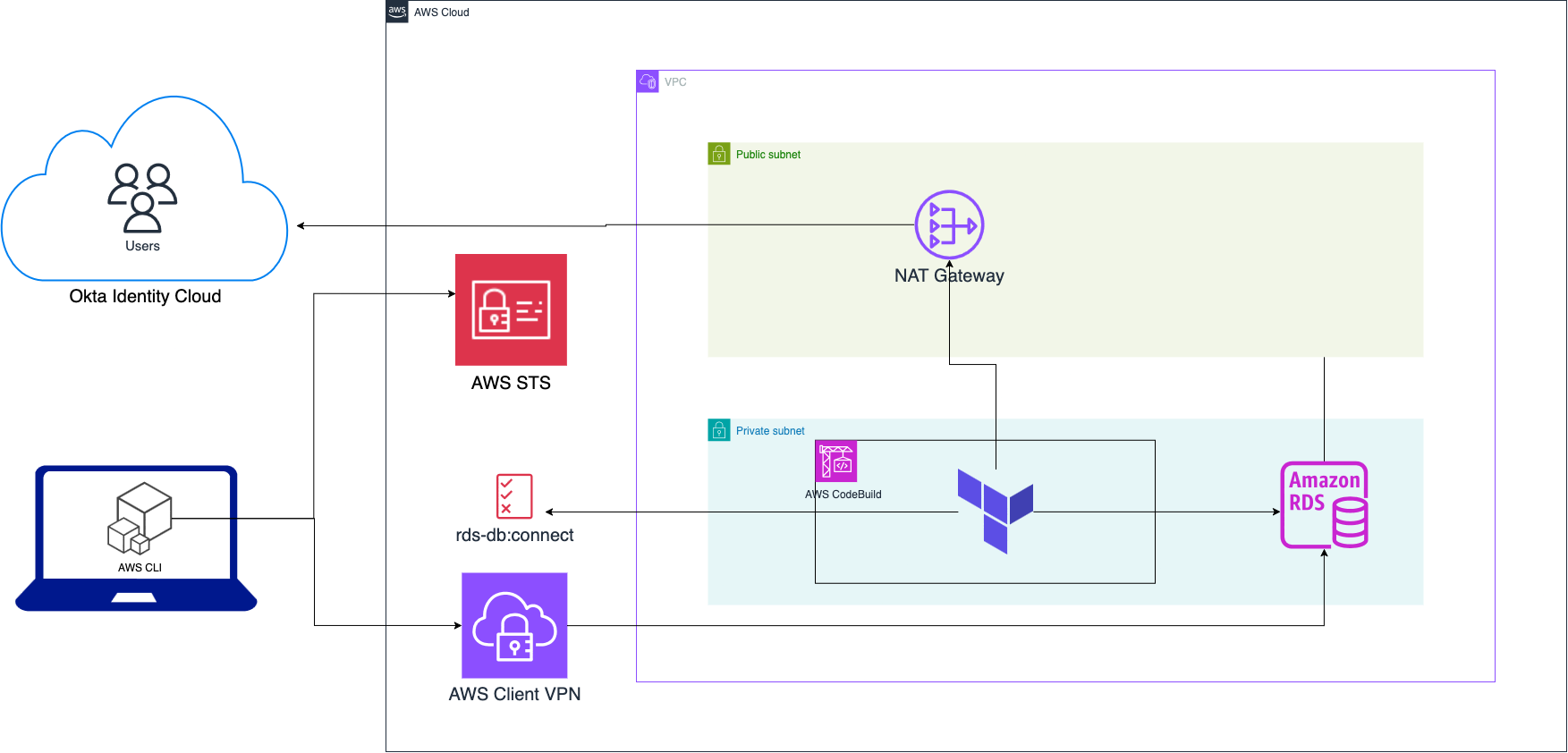
- Users are managed in Okta Identity Cloud
- Terraform deploys the RDS database within a private subnet
- Terraform creates
rds-db:connectIAM policy using db identifier and policy variable - Terraform retrieves user and group information from Okta and creates roles for said users in DB
- Terraform attaches policy to corresponding Okta groups in IAM Identity Center
- Users obtain temporary database credentials using IAM Identity Center
- Users connect to the RDS database via AWS Client VPN and temporary database credentials
Note: While we use a VPN here, you can still achieve the same using SSM Port Forwarding via an EC2 instance or ECS Fargate task.
Setup Okta
Obtain Okta API Credentials
Since we'll be accessing the Okta API from Terraform, we need to setup an Okta application that will provide the credentials. Follow the guide at Enable Terraform access for your Okta org to get setup. The steps abbreviated are:
-
Create an API service app
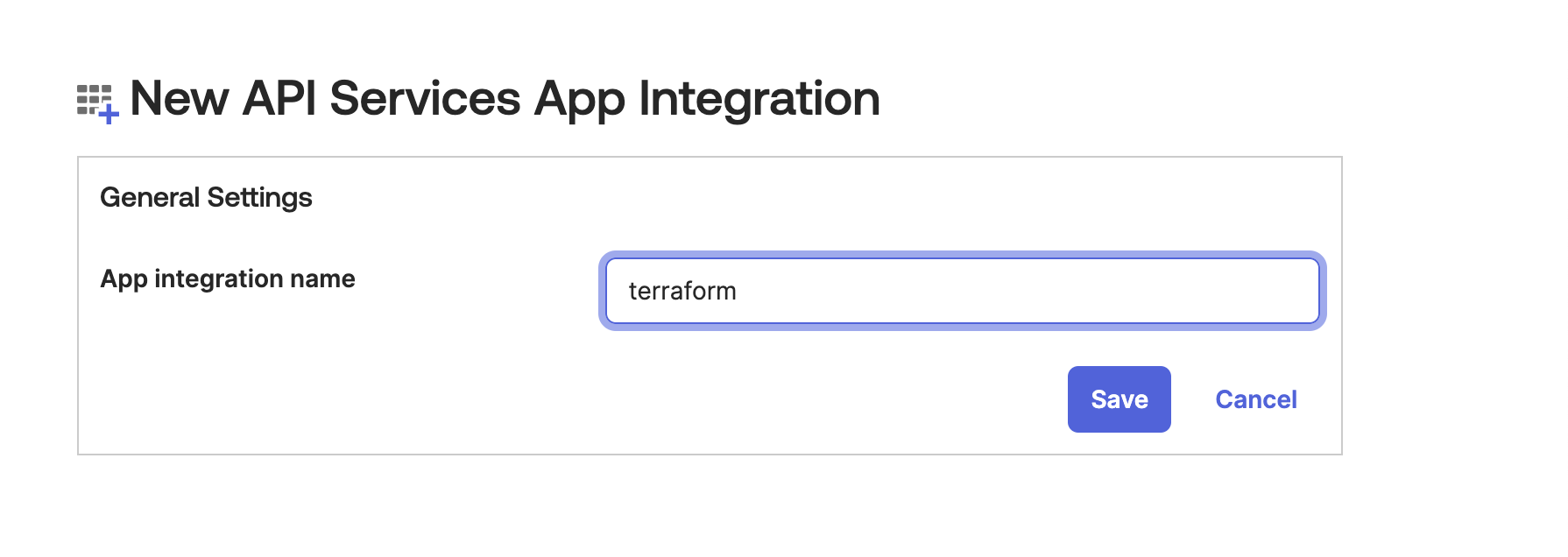
-
Assign your app an admin role
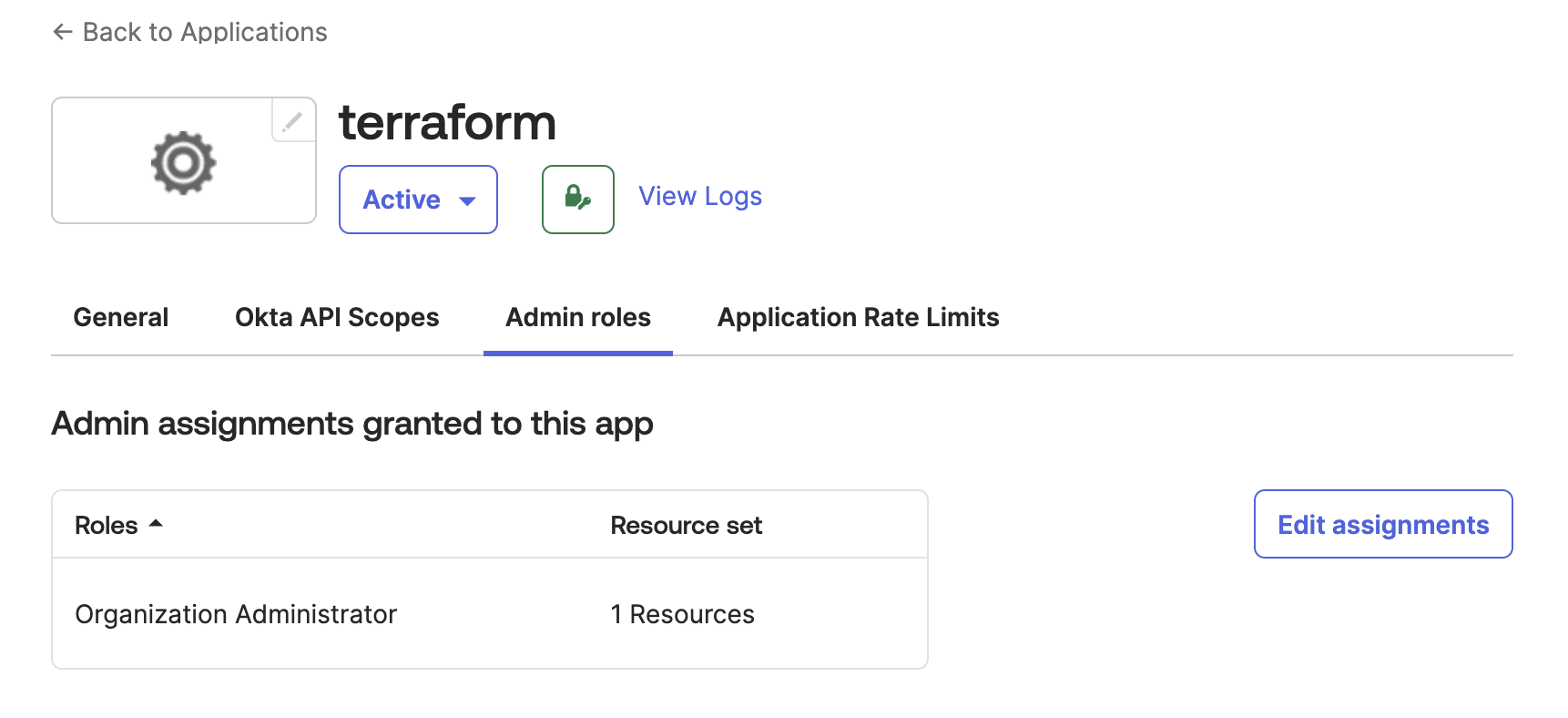
-
Grant your app API scopes
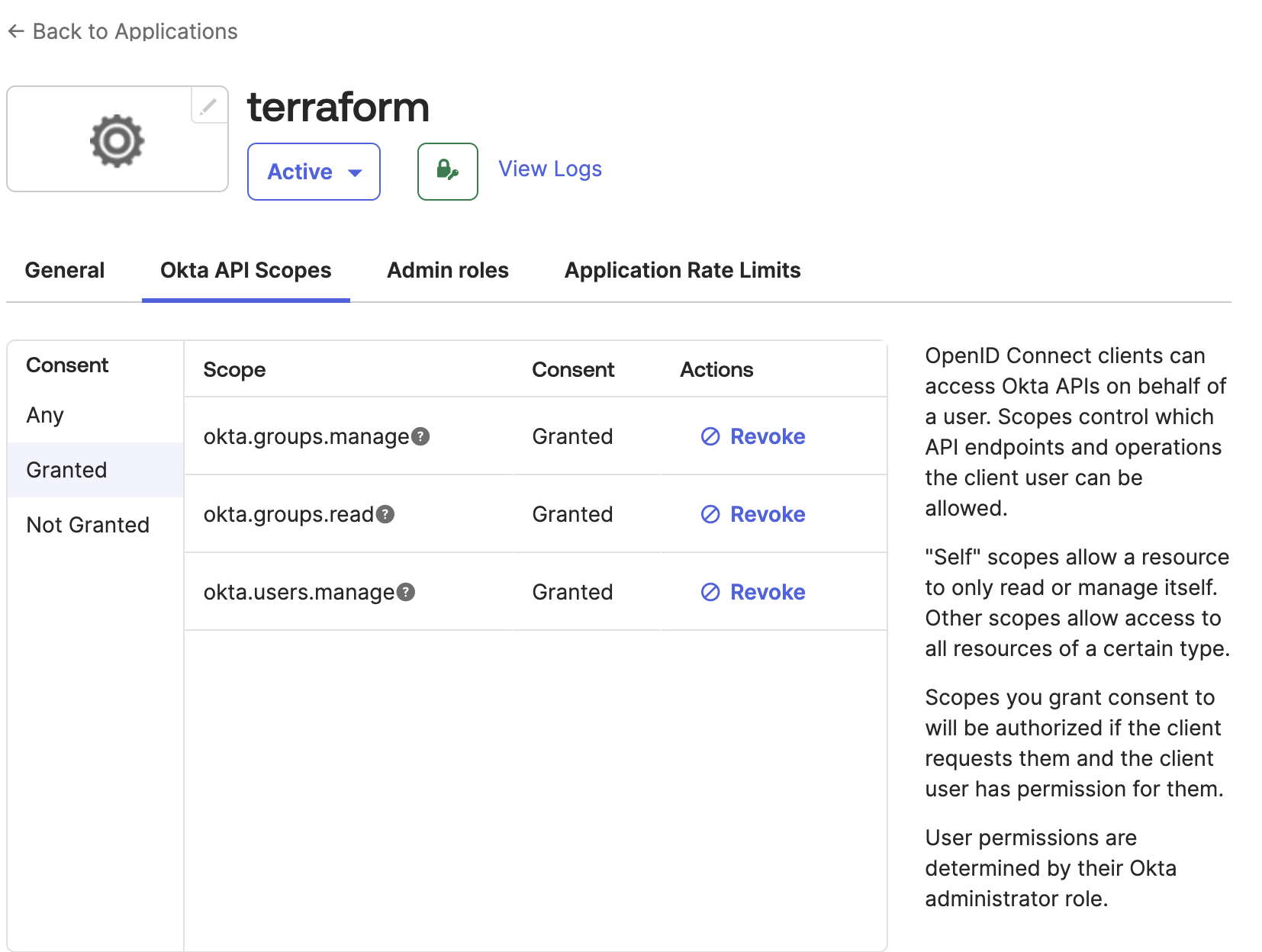
-
Create access credentials using PEM format
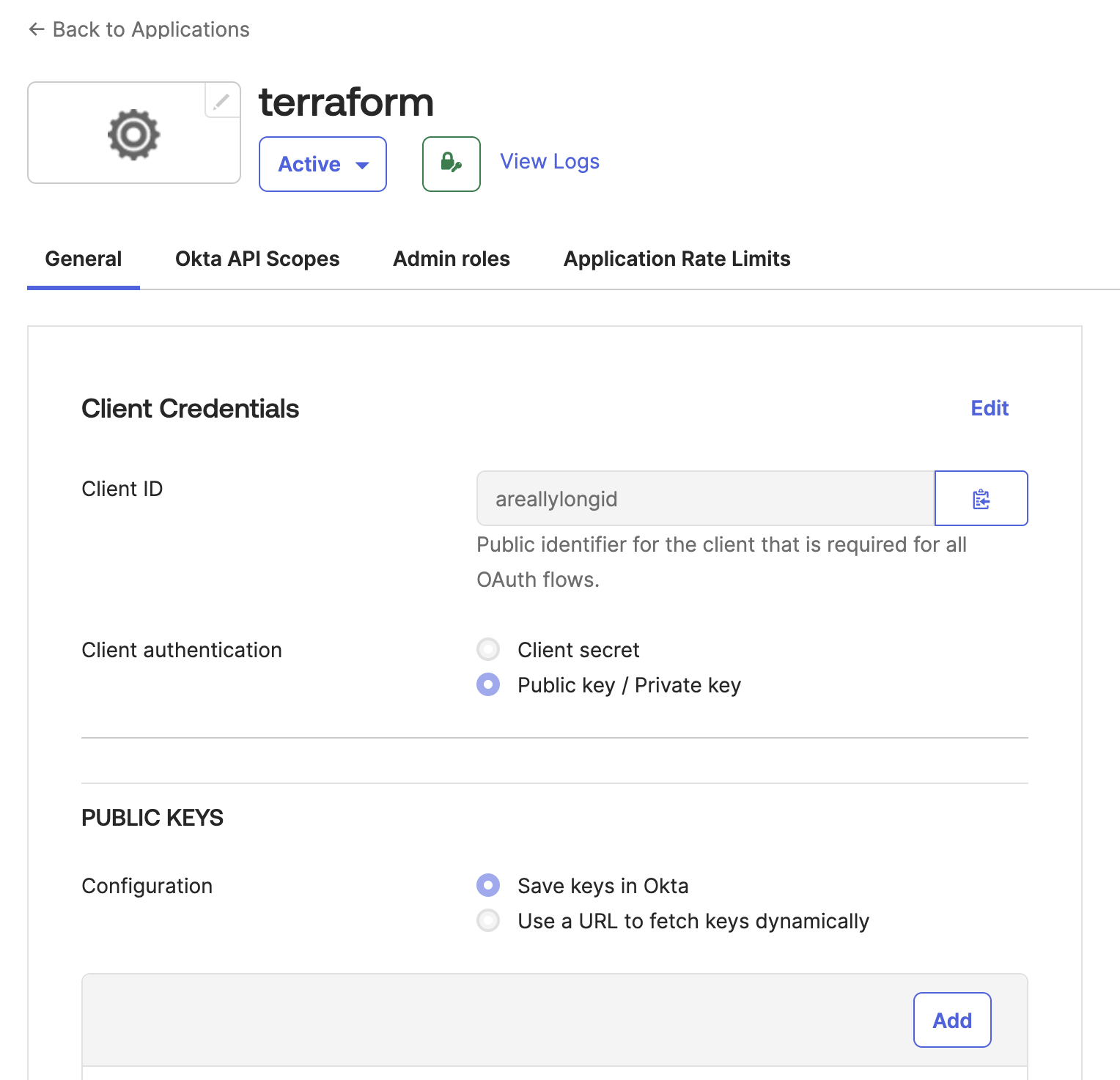
Caution: The private key appears in this dialog only once. Losing the private key requires generating a new key pair.
Add credentials to Terraform
-
Next, lets create an AWS secret manager resource to store this credential.
resource "aws_secretsmanager_secret" "okta_private_key" { name = "okta-private-key" description = "Private key for Okta API access" }We don't create an
aws_secretsmanager_secret_versionresource here intentionally as we'll be creating and managing it manually via the web console. This is sometimes done for compliance reasons where secret creation for certain high value secrets most involve a manual auditable step. -
Next add the okta provider to the
required_providers. Update the version to the latest available version on the Okta Provider page.terraform { required_providers { okta = { source = "okta/okta" version = "~> 4.19.0" } } } -
Then, add the provider to your
providers.tf.Note our usage of the
ephemeralresource to retrieve and pass the okta private key to the Okta provider. Ephemeral resources in Terraform are not persisted to the state file which is ideal for a secret of this nature.ephemeral "aws_secretsmanager_secret_version" "okta_private_key" { secret_id = aws_secretsmanager_secret.okta_private_key.id } provider "okta" { # org_name is first part of orgs's Okta domain before .okta.com org_name = "{yourOktaOrg}" base_url = "okta.com" client_id = "{yourClientID}" scopes = ["okta.groups.manage","okta.users.manage"] private_key = ephemeral.aws_secretsmanager_secret_version.okta_private_key.secret_string } -
Finally, test access with a resource and output
data "okta_group" "admins" { name = "Admins" } output "okta_group" { value = data.okta_group.admins.id }Running
terraform planshould show the group id.
If you hate the idea of doing anything in the web console, or your compliance environment allows for it, you could create the okta credential using aws_secretsmanager_secret_version with the value passed via a TF_VAR_name environment variable and secret_string_wo. The wo refers to write-only, a new argument that tells terraform that we don't want it storing the value in the state file, now, or ever.
Provision the Amazon RDS Postgres Database
Let's use the modules from Terraform AWS modules to setup our DB. IAM database authentication works with MariaDB, MySQL, and PostgreSQL, but for this guide, we'll focus on PostgreSQL.
First, we'll create a security group.
module "security_group" {
source = "terraform-aws-modules/security-group/aws"
version = "~> 5.0"
name = local.name
description = "Complete PostgreSQL example security group"
vpc_id = aws_vpc.main.id
# ingress
ingress_with_cidr_blocks = [
{
from_port = 5432
to_port = 5432
protocol = "tcp"
description = "PostgreSQL access from within VPC"
cidr_blocks = aws_vpc.main.cidr_block
},
]
tags = local.tags
}
Next, let's setup the db.
module "db" {
source = "terraform-aws-modules/rds/aws"
identifier = local.name
# All available versions: https://docs.aws.amazon.com/AmazonRDS/latest/UserGuide/CHAP_PostgreSQL.html#PostgreSQL.Concepts
engine = "postgres"
engine_version = "14"
engine_lifecycle_support = "open-source-rds-extended-support-disabled"
family = "postgres14" # DB parameter group
major_engine_version = "14" # DB option group
instance_class = "db.t4g.large"
allocated_storage = 20
max_allocated_storage = 100
db_name = "completePostgresql"
username = "complete_postgresql"
port = 5432
iam_database_authentication_enabled = true #--> needed for IAM auth
manage_master_user_password_rotation = true
master_user_password_rotate_immediately = false
master_user_password_rotation_schedule_expression = "rate(15 days)"
}
The essential options here are iam_database_authentication_enabled = true, which enables IAM authentication for the database, and manage_master_user_password_rotation = true, which lets AWS automatically manage and rotate the master password using Secrets Manager.
Grant IAM database access
As mentioned earlier, IAM Database access relies on the rds-db:connect permission. The rds-db: prefix and rds-db:connect actions are only valid in the context of IAM database authentication.
While you can assign this permission with a wildcard, granting access to any database in the account, we're going to do the right thing™ and use least privilege. To do this, we'll take advantage of a neat little trick, IAM policy variables.
Write DB access IAM policy
You use IAM policy variables as placeholders when you don't know the exact value of a resource or condition key when you write the policy.
Without this, we'd have to create a policy statement for each user that needs access in a group. Beyond being unwieldy and inelegant, this approach doesn't scale because we'll quickly run into IAM policy character limits.
Instead, we'll lean on the saml:sub policy variable, one of the ways to uniquely identify users in SAML-based federation. saml:sub is the subject of the claim, which includes a value that uniquely identifies an individual user within an organization. At most orgs, this is the user's email, e.g. you@yourcompany.com. In other words, the effectiveness of the saml:sub policy hinges on the SAML assertion from Okta mapping the user's subject field to the email.
Here's the policy - the join function is only used to allow display of the full arn in the code snippet.
data "aws_iam_policy_document" "db_access" {
statement {
sid = "1"
actions = [
"rds-db:connect",
]
resources = [
join(
"",
[
"arn:aws:rds-db:${var.region}:",
data.aws_caller_identity.current.account_id,
":dbuser:",
module.db.db_instance_resource_id,
"/",
"$${saml:sub}"
]
)
]
condition {
test = "StringEquals"
variable = "saml:sub_type"
values = ["persistent"]
}
}
}
resource "aws_iam_policy" "db_access_policy" {
name = "rds-db-access-policy"
path = "/"
policy = data.aws_iam_policy_document.db_access.json
}
Notice that we have to escape the literal ${ in $${saml:sub} that would otherwise introduce a template sequence.
TODO: Add note about saml:sub_type being set to persistent condition check.
Create permission set
A permission set in AWS IAM Identity Center is analagous to an IAM Role in classic IAM. It defines the permissions that a federated user will get during their short-lived session.
We'll create a permission set that will be assumed by our users when they want to connect to the DB. This permission set doesn't have to be solely used for db access, it could just as well be a permission set that grants other permissions in addition to db access.
data "aws_ssoadmin_instances" "sso" {
}
resource "aws_ssoadmin_permission_set" "db_access_permission_set" {
name = "db_access_permission_set"
description = "Permission set for RDS DB access via IAM"
instance_arn = data.aws_ssoadmin_instances.sso.arns[0]
session_duration = "PT1H"
tags = {
Purpose = "RDS DB Access"
}
}
Attach IAM DB access policy to permission set
For the permission set to grant access, it needs a policy attachment. That's what we're doing here:
resource "aws_ssoadmin_customer_managed_policy_attachment" "db_access_policy_attachment" {
instance_arn = aws_ssoadmin_permission_set.db_access_permission_set.instance_arn
permission_set_arn = aws_ssoadmin_permission_set.db_access_permission_set.arn
customer_managed_policy_reference {
name = aws_iam_policy.db_access_policy.name
path = "/"
}
}
Assign permission set to account where DB resides
Account assignment is where you assign a permission set to a user or group for a specific AWS account. IAM Identity Center then provisions an IAM Role in that account with policies attached that reflect the permissions defined in the permission set.
data "aws_identitystore_group" "admins" {
identity_store_id = tolist(data.aws_ssoadmin_instances.sso.identity_store_ids)[0]
alternate_identifier {
unique_attribute {
attribute_path = "DisplayName"
attribute_value = data.okta_group.admins.name
}
}
}
resource "aws_ssoadmin_account_assignment" "assign_admins" {
instance_arn = tolist(data.aws_ssoadmin_instances.sso.arns)[0]
permission_set_arn = aws_ssoadmin_permission_set.db_access_permission_set.arn
principal_id = data.aws_identitystore_group.admins.group_id
principal_type = "GROUP"
target_id = data.aws_caller_identity.current.account_id
target_type = "AWS_ACCOUNT"
}
Provision users in the DB
IAM DB authentication requires the users to have DB users that are mapped to an IAM user or role. Our users already exist as IAM Identity Center users via the Okta/IAM Identity Center integration, and above, we just granted them the IAM permissions to access the DB. What's left is to create the equivalent users in the DB.
When granting access however, it's crucial to also plan for revocation. We'll tackle this DB user provisioning and revocation here, starting with revocation.
Planning for User Revocation
When users leave the organization or lose access permissions, we need to both remove their database roles AND terminate any active sessions they might have.
You should have this project run as part of both your onboarding and offboarding. With Okta Event hooks you can trigger the GitHub pipeline using the repository_dispatch event. This will update the roles in the database, ensuring that it matches the state in Okta.
For our revocation mechanism, we'll create a bash script that is responsible for revoking active user sessions. The postgresql_role resource we'll create shortly handles the declarative removal of the role from the database. Our script serves a different, specific purpose: to terminate active connections, which would otherwise persist until the user manually disconnects. Note that for this to work your Terraform runner environment must have psql and jq installed.
#manage_all_user_sessions.sh
#!/bin/bash
OUTPUT_FILE="terminated_sessions.json"
# Initialize/create the output file with an empty JSON array.
# This ensures the file exists even if the script exits prematurely later.
# Convert Okta users JSON to SQL array
OKTA_USERS_SQL_ARRAY=
# SQL query to find and terminate sessions for non-superusers not in the Okta list,
# and return a JSON array of the terminated usernames.
SQL_QUERY="
SELECT COALESCE(json_agg(usename), '[]'::json)
FROM (
SELECT usename, pg_terminate_backend(pid)
FROM pg_stat_activity psa
JOIN pg_roles pr ON psa.usesysid = pr.oid
WHERE
psa.pid <> pg_backend_pid()
AND psa.usename ~ '^[a-zA-Z0-9._%+-]+@[a-zA-Z0-9.-]+\\.[a-zA-Z]{2,}$'
AND psa.usename <> ALL ()
AND pr.rolname <> 'rdsadmin'
AND pr.rolcanlogin
AND NOT pr.rolsuper
) t;
"
# Execute the query and capture the resulting JSON array.
TERMINATED_USERS_JSON=
# Write the JSON array of terminated users to the output file.
# If the query returned nothing, write an empty array.
Our SQL query uses the most recent user list from Okta to determine which active user sessions in the DB should be terminated. It takes advantage of pg_terminate_backend and pg_stat_activity to figure out the active sessions, and terminate those that belong to users that are no longer authorized.
Running the revocation script
We begin breaking some rules of proper Terraform automation here. Many consider writing directly to a database during a terraform apply to be an anti-pattern. This is because it moves us away from simply provisioning resources, to mutating data or application state that it is argued should ideally be managed outside of the declarative infrastructure lifecycle.
However, the real world is messy, and sometimes a sparing and conscious hack like this is a perfectly reasonable compromise. Just be sure to document it and understand the risks.
Lets grab the users we intend to grant access to. We're using Admins here, but it could as well be Developers, DBAs, Data Analysts or whatever group needs access. Note also that what we're about to do, writing to the database, only works if your Terraform runner also has network access to the just created DB.
data "okta_users" "admins" {
group_id = data.okta_group.admins.id
}
Next we'll call our revocation script using the list of okta_users.
ephemeral "aws_secretsmanager_secret_version" "secret-version" {
secret_id = module.db.db_instance_master_user_secret_arn
}
locals {
host = substr(module.db.db_instance_endpoint, 0, length(module.db.db_instance_endpoint) - 5)
username = "complete_postgresql"
database = "completePostgresql"
terminated_sessions_file = "${path.module}/terminated_sessions.json"
}
resource "terraform_data" "terminate_stale_sessions" {
# This ensures the script re-runs whenever the list of Okta users changes.
triggers_replace = data.okta_users.admins.users[*].email
provisioner "local-exec" {
command = "bash ${path.module}/manage_all_user_sessions.sh"
interpreter = ["/bin/bash", "-c"]
# Pass all parameters as environment variables
environment = {
PGPASSWORD = local.password
DB_HOST = local.host
DB_ADMIN_USER = local.username
DB_NAME = local.database
OKTA_USERS_JSON = jsonencode(data.okta_users.admins.users[*].email)
}
}
lifecycle {
create_before_destroy = true
}
depends_on = [module.db]
}
# Data source to read the file generated by the script
data "local_file" "terminated_sessions_report" {
filename = local.terminated_sessions_file
# Ensure this runs after the script has potentially (re)created the file
depends_on = [terraform_data.terminate_stale_sessions]
}
output "terminated_sessions_info" {
description = "Information about terminated database sessions based on Okta user list."
value = jsondecode(data.local_file.terminated_sessions_report.content)
}
We use the terraform_data resource, the native successor to null_resource, because it doesn't require a provider to be configured.
Provision the user roles in the DB
Next, we'll use the latest Okta user list to create matching roles in the database. For this, we'll leverage a Terraform PostgreSQL provider. To configure the provider, we'll retrieve the AWS-managed master password from the RDS module and use it to authenticate. Once again, we'll use the ephemeral resource type.
terraform {
required_providers {
# other providers omitted
postgresql = {
source = "cyrilgdn/postgresql"
version = "1.25.0"
}
}
}
provider "postgresql" {
host = local.host
database = local.database
username = local.username
password = local.password
sslmode = "require"
connect_timeout = 15
superuser = false # required for RDS users. AWS doesn't grant us superser, but instead `rds_superuser`
}
We can now use the postgresql_role resource to create our users, making sure to grant them the rds_iam permission. IAM authentication takes precedence over password authentication, so any users granted rds_iam must log in as an IAM user.
resource "postgresql_role" "okta_users" {
for_each = toset(data.okta_users.admins.users[*].email)
name = each.value
login = true
roles = ["rds_iam"] # needed for IAM auth
depends_on = [module.db, module.security_group]
}
Profit
We now have everything needed to connect to our AWS RDS DB via IAM. To do so, we obtain an IAM authentication token using the AWS CLI, and then use said token as our password. Here are the steps:
-
Set AWS environment variables - this could be via
aws sso logindirectly or using a tool like granted -
Download the required SSL certificate from https://truststore.pki.rds.amazonaws.com/global/global-bundle.pem
curl -O https://truststore.pki.rds.amazonaws.com/global/global-bundle.pem -
Export your DB host address to your current terminal:
-
Generate the IAM token using your Okta email:
-
Connect to your DB using the IAM token and the SSL certificate:
If everything worked out, you should see your psql prompt:
psql (17.5, server 14.17) SSL connection (protocol: TLSv1.2, cipher: ECDHE-RSA-AES256-GCM-SHA384, compression: off, ALPN: none) Type "help" for help. completePostgresql=>
Note that the generated token works just as well in pgAdmin, DataGrip, or your favorite database IDE.
Wrapping up
Now that our developers can access our database using IAM Database authentication, its worth pointing out some key concerns and limitations. First, developers might find the steps needed to obtain the token cumbersome. You should therefore wrap the individual AWS CLI calls in a custom, organization-specific script or CLI tool.
You'll likely need to grant additional privileges beyond just rds_iam to allow your users query or perform other actions on the database. When you do this, you must ensure that you never grant devs the permission to create roles. This prevents bypassing IAM authentication. Also consider managing schema and sequence privileges using IaC. This keeps all DB user privilege management operations version-controlled and will likely make your security auditors very happy.
With regards to limitations, perhaps the most important is that CloudWatch and CloudTrail don't log IAM Database authentication events. CloudWatch and CloudTrail do not track the generate-db-auth-token API calls that authorize the IAM role to enable database connection.
Hence, if you're building this as part of some audit trail infrastructure, you might want to setup your own near real-time notification mechanism using the aws_lambda extension. This works on both RDS for PostgreSQL and Aurora PostgreSQL. Additionaly, you'll likely want to setup pgaudit for comprehensive auditing and pgAudit Analyze for easier querying of said auditing.
That said, I find these tradeoffs acceptable. By automating the entire lifecycle with Terraform, from database provisioning to user role management, we reduce the operational burden of supporting engineering teams. Your developers get secure, individualized database access without compromising on security best practices, and your security team gets centralized control over who can access what, when.
Thanks to Jason Anderson and Matthew Nichols for their thoughtful feedback and suggestions.